The Miniature Rooms of Narcissa Niblack Thorne
The Thorne miniature rooms are the brainchild of Narcissa Thorne, who crafted them between 1932 and 1940 on a 1:12 scale. Incredibly detailed and...
Maya M. Tola 9 January 2025
5 September 2022 min Read
Did you know that the Arts and Crafts Exhibition Society which was founded in 1887 by William Morris and Walter Crane is still thriving today? Currently known as the Society of Designer Craftsmen, it grew out of the Arts and Crafts movement. This was one of the most influential, profound and far-reaching design movements of modern times. We took a moment to have a chat with a Trustee of the society, Dan Maier.
The Society celebrates designers and craftspeople. They are selected for their innovative design sense and exceptional skills and sensitivity to materials. SDC is the oldest multi-disciplinary society in the UK. Its members are some of the finest, most exciting and respected designer-makers of today. They work in ceramics, wood, metal, glass and textiles.
Dan Maier, the current Trustee of the society, is a woman of many talents. A special commission of her Knitted Chandeliers for a Wallis store Christmas window display led to a career spanning over 10 years in designing and manufacturing lighting. This resulted in several best-selling designs for major UK retailers.
She works from her Extraordinary Design studio in London. Her specialism is in bespoke decorative pieces for window displays, theatre, and interiors. In addition, she has recently completed her first piece of public art. Her clients include retailers such as Harvey Nichols, Liberty and Heals. She has also worked for a number of theaters. These include The Old Vic, the Young Vic, the National, and the Royal Shakespeare Company.
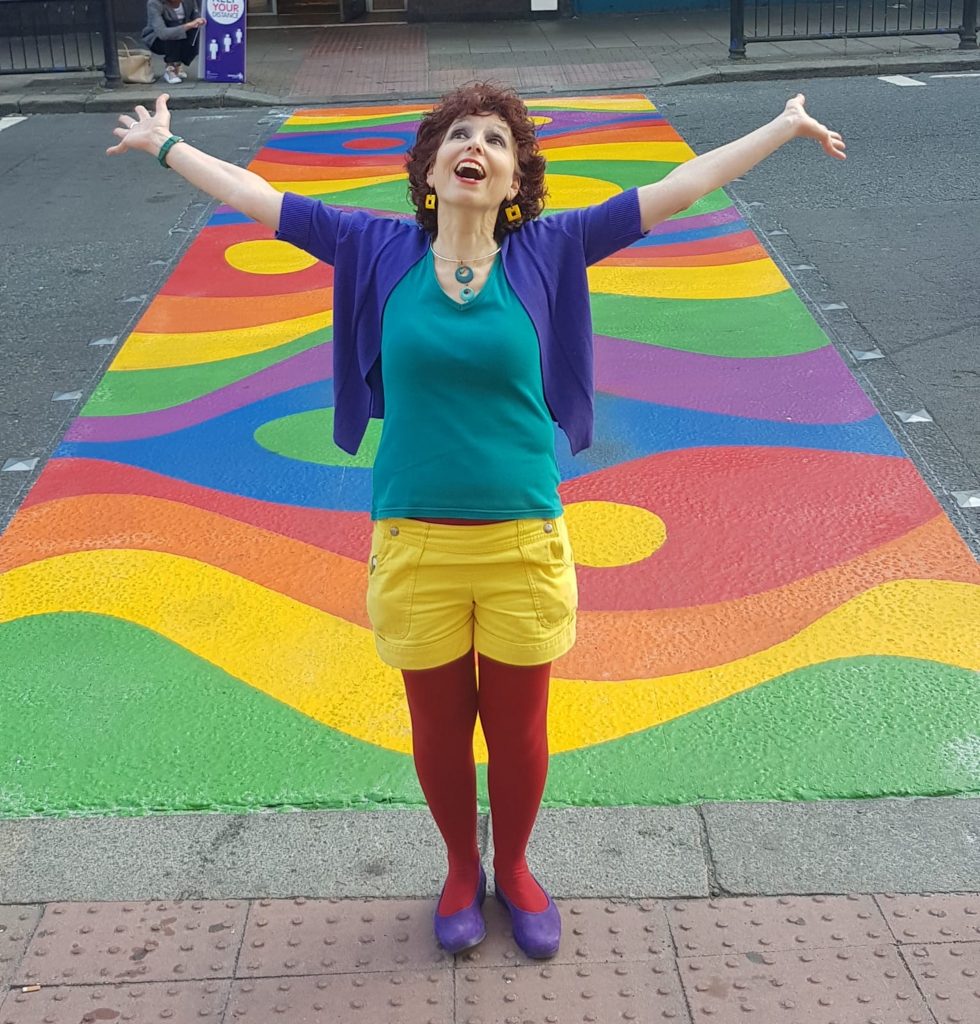




















NF: Hi Dan, thank you for taking the time to speak with the DailyArt Magazine. We wondered, do you have a favorite museum or a monument?
DM: Parc Guell in Barcelona. I first visited Barcelona when I was a student and was awestruck by Gaudi’s incredible buildings. I wanted to go back for years and years and when I finally made it and stepped off the bus at the entrance to Parc Guell I found tears running down my cheeks. That’s never happened to me before.
NF: Looking back on your success from your early pieces, followed by commissions from the best home furnishing stores in London and international acclaim. Did you instinctively know your knitted light-shades and mixed media designs would generate so much interest?
DM: I had no idea! When I graduated from Central St Martins, I was making knitted sculptures. I hadn’t a clue as to how I would make a living. It was a commission for Wallis’s Christmas windows – when I created 75 knitted hangings (in a silver ribbon yarn to look like chainmail) that literally led to a light bulb moment. I thought if I put a light bulb in these, my knitted sculptures become lampshades which will be much easier to sell. Little did I know that what started off as a mini production line for some “bread and butter” income whilst working on bespoke commissions, would become an all-consuming business, selling around the world! So that’s how my Knitted Chandeliers were born!
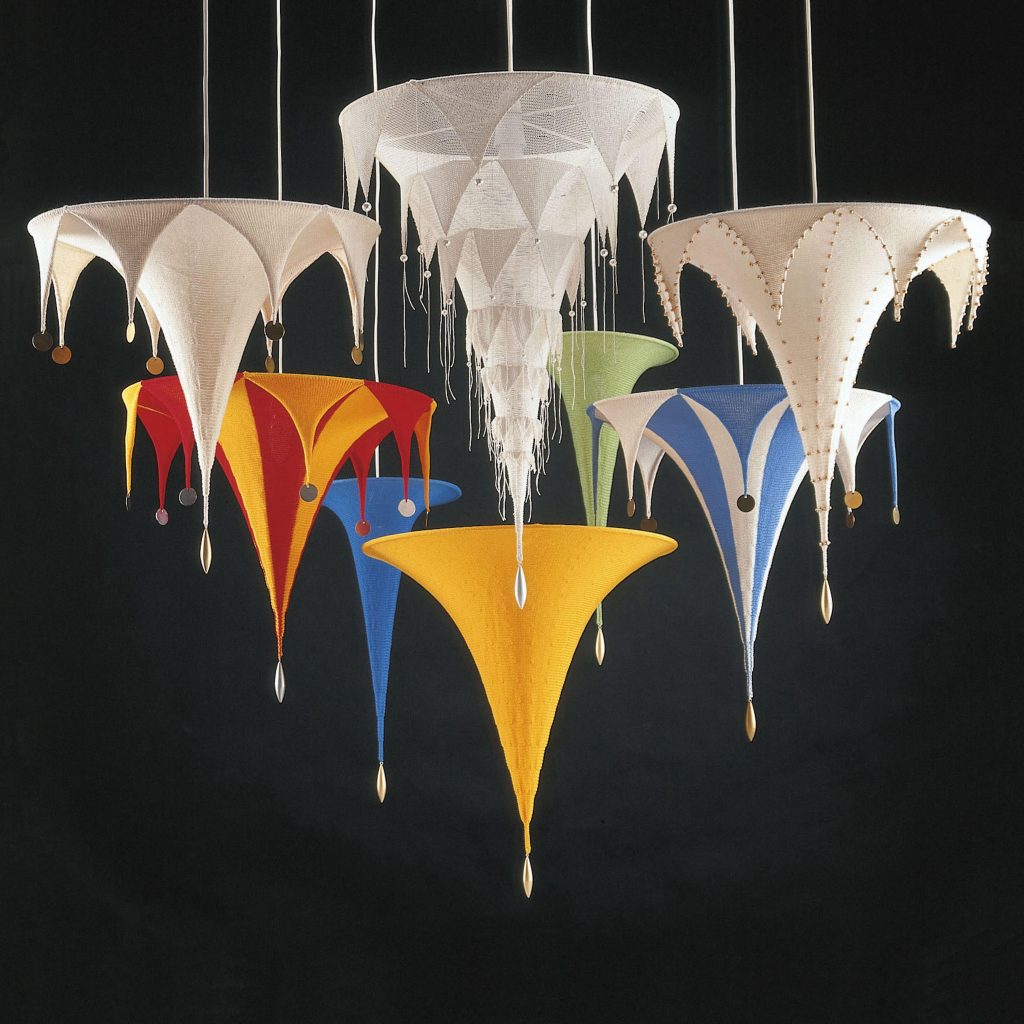























NF: Your work has a kind of 1960s to 1970s style. For example, your colorful appliqué silk boot panel is reminiscent of that technicolor era, and your installations also include rainbow colors. Was the mood and music of the period an influence on your ideas and thought processes?
DM: Interesting you say this… I always wished I’d been born earlier to make the most of those decades. I’m a great admirer of designers and artists of the 1950s, 1960s, and 1970s. I thought Verner Panton’s vibrant interiors were pretty mind-blowing. And it was not only the colors but the unconventional forms he created.
Also, I grew up watching Hollywood technicolor movies with my dad on Sunday afternoons, which probably had an influence. But I have an innate sense of color, often using complementary colors together. My “Mr. Magnolia partner” has, on more than one occasion, referred to me as a “color fascist” as I’m regularly heard pronouncing that something is “the wrong yellow”. I believe color is a powerful mood enhancer and it’s important to get it right. I always wear bright colors and when I meet people on grey winter days, they react so positively to me; it’s a no-brainer!
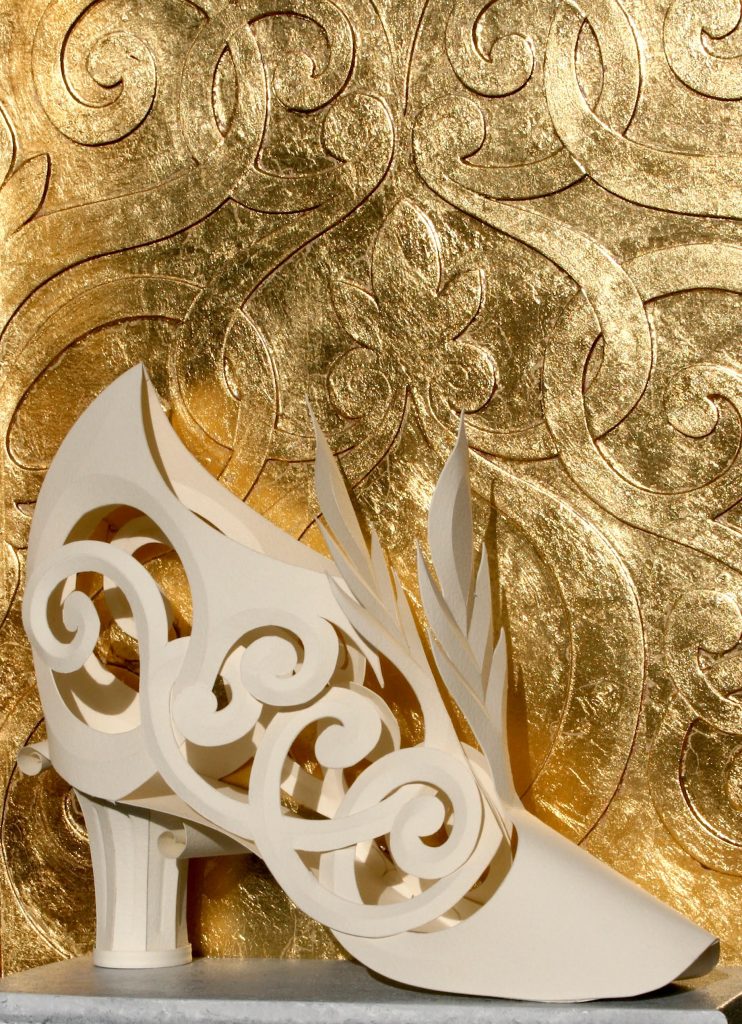























NF: What’s your favorite material to work with and why?
DM: I don’t really have one. I’m fascinated by so many different materials and processes. I translate my designs into different media depending if the end use is indoor or outdoor, etc. So, a textile design can be produced in steel for example. I’m currently quite excited about paper sculpting which is a technique I used for some commissions for the Royal Caribbean International Cruise liners.
NF: What’s your favorite art period and what artists have inspired you?
DM: It’s quite an eclectic mix. My favorite designers, architects and artists are from the 1950s and 1960s. They include Arne Jacobson, Verner Panton, Bridget Riley and Alexander Calder. But I also love Georgia O’Keefe, Antoni Gaudi and Santiago Calatrava. My dad was an architect and I grew up eating at an Eero Saarinen table. So that was clearly an early influence!
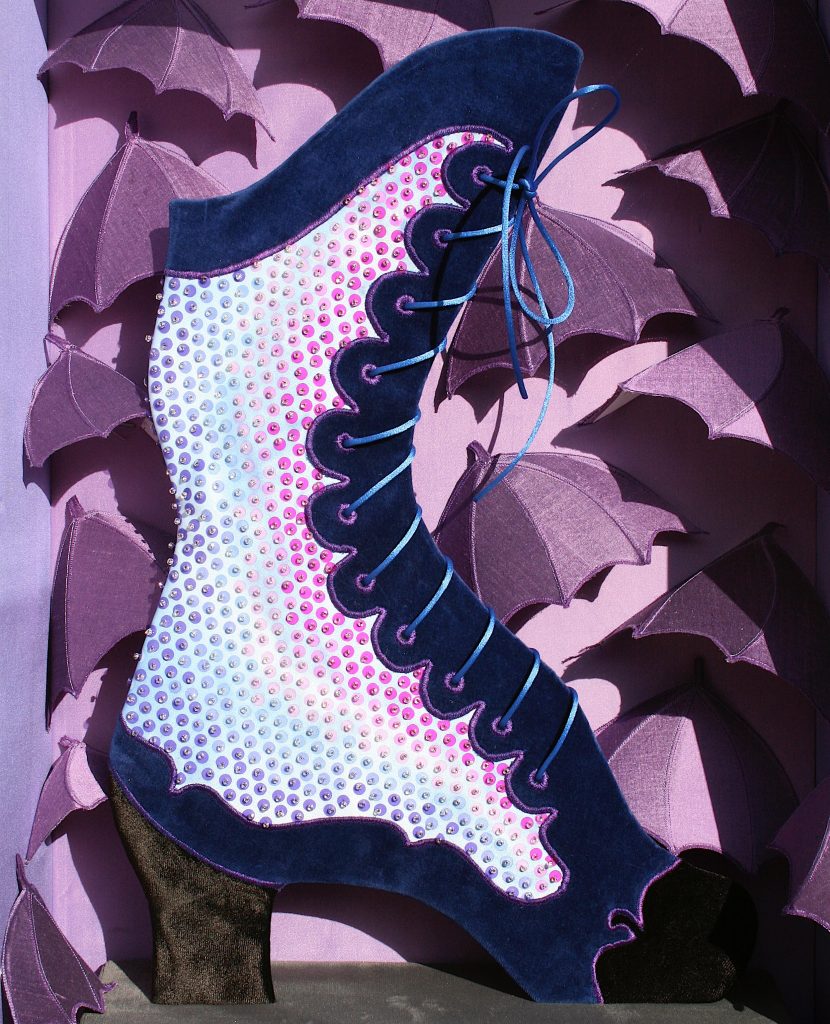























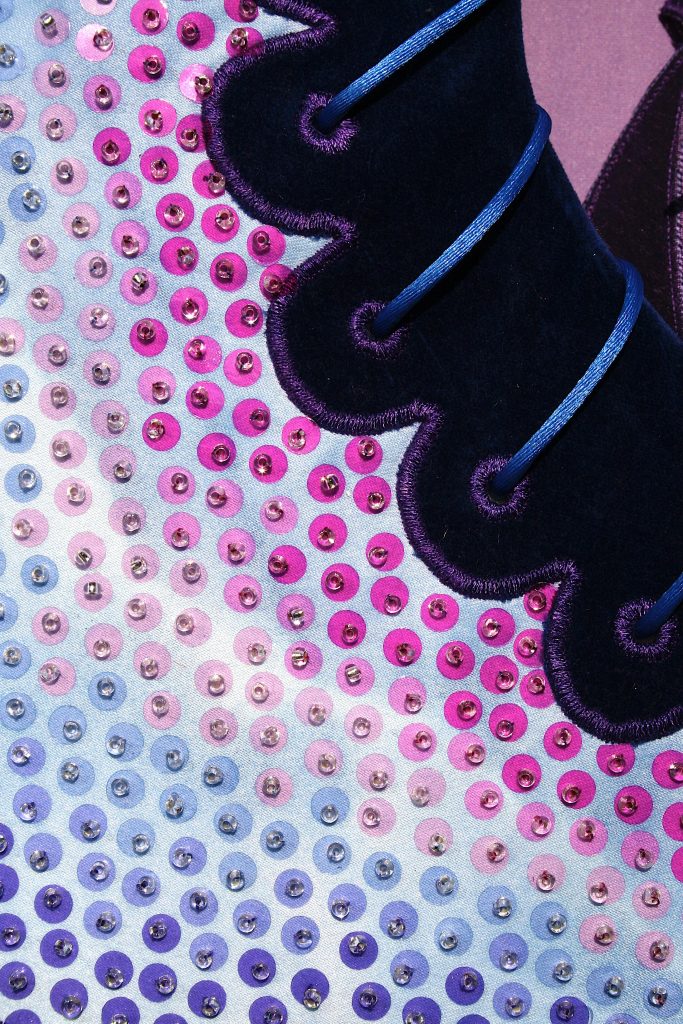























NF: Your work to date has been seen round the globe, and even the sea. What has been your most challenging project?
DM: Gosh, that’s a tough one as each project has its own challenges, but one that springs to mind is the 30-foot long giant fabric whale that I made for Pinocchio at the National Theatre. It had to be completed in about 4 weeks and had to be articulated with a fish-like movement and opening jaws in order to swallow Gepetto and Pinocchio…
On these kinds of projects, I think of myself as a fabric engineer. When you’re making props, it’s often effectively a prototype, so you’re forever inventing ways to make things and adapting processes in different contexts. It might sound crazy but we cut the vast pattern pieces for the fabric out of 8’ x 4’ sheets of hardboard using a CNC laser cutting machine, as we didn’t have a wide enough paper printer but the weight of the hardboard actually made it easier to mark up the fabric than using paper. This was also surprisingly the most cost-effective way of doing it at the time.
NF: You completed several commissions for the Royal Caribbean International Cruise liners, can you tell us which you enjoyed creating most?
DM: Yes I’ve made around 20 works for the RCI liners, all of which have been great. The one I probably enjoyed the most was the brief to create works on the themes of different art movements for each deck. The idea being that people would orientate themselves by knowing that they were on the Impressionist or Renaissance deck for example. I decided to create a series of footwear whose silhouettes would all be in the style of the era of each art movement but be decorated in the style of the art movement. So I had a Victorian style Impressionist boot decorated in over a thousand hand-cut sequins representing pointillism… and, as I’m sure you’re wondering, the reason I individually hand punched them, was to be sure to get the right colors!
Another one was the Expressionist Boot you mentioned earlier which was a 1920’s style boot, decorated in bright silk appliqué – a design inspired by a Franz Marc painting – the most colorful expressionist work I could find! And I even did a Jackson Pollock-esque 1960s patent platform boot!
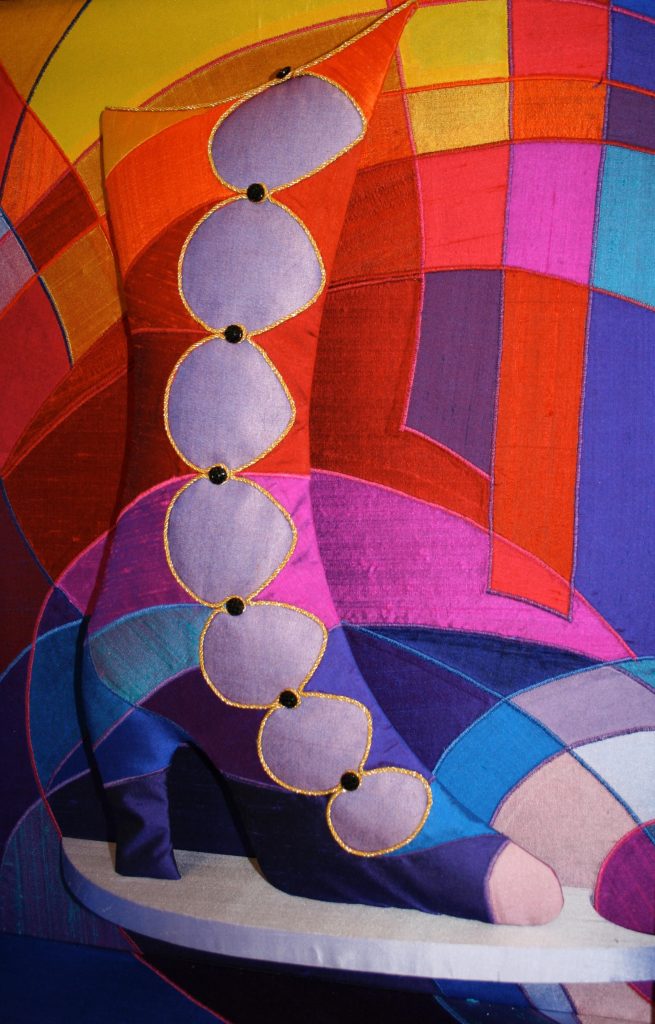























NF: Your role as a Trustee of the Society of Designer Craftsmen no doubt means that you are extremely busy, but have you personally got any future art projects lined up that you can give us a sneak preview of?
DM: Yes, the SDC does keep me busy, but it’s very rewarding being part of such a highly esteemed society with such a rich history. I’m working on a couple of exciting projects at the moment, one is a mural for a private house in London and the other is transforming a VW campervan exterior based on the psychedelic art crossing I designed for Southgate High Street. I was overwhelmed by the tremendous feedback from the public to my colorful abstract design which sits in the grey urban landscape – there is clearly an appetite for some color therapy!
Author’s bio
Nicola Ferlei-Brown is a writer and Art Historian from London. After studying History of Art and Architecture, the road led her to Italy, where she is often found at the Roman forums, or underneath them. Her work covers everything from ancient mosaics to Baroque, modern-day design and all things divine. Check out her Instagram and website.
DailyArt Magazine needs your support. Every contribution, however big or small, is very valuable for our future. Thanks to it, we will be able to sustain and grow the Magazine. Thank you for your help!